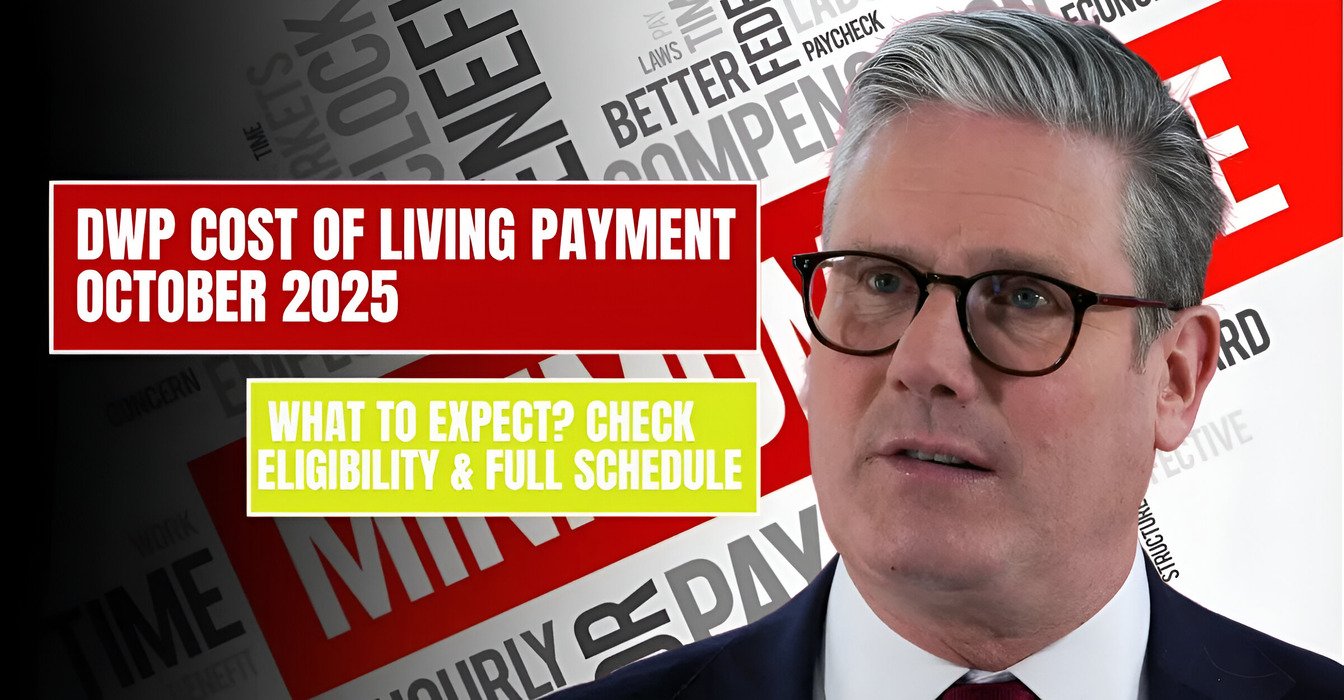DWP Cost of Living Payment October 2025: What to Expect? Check Eligibility & Full Schedule
DWP Cost of Living Payment October 2025 arrives as welcome news for millions of households across the UK who are still facing the pressure of rising costs. With inflation, housing expenses, and energy bills continuing to rise, the government’s targeted support provides timely relief, especially for low-income families and pensioners. The Department for Work and Pensions (DWP) has structured these payments to reach those most in need—without requiring them to apply or fill out forms.
Set against a backdrop of persistent financial stress, this scheme is part of a three-phase initiative designed to help households during the most demanding parts of the year. The DWP Cost of Living Payment October 2025 will be the final and most generous phase, and it’s aimed at easing burdens during colder months and the holiday season. This article breaks down who qualifies, how much to expect, and what the full schedule looks like so you can stay prepared and informed.
Overview Table: DWP Cost of Living Payment 2025 Breakdown
| Phase | Date Range | Payment Amount | Purpose |
| Phase 1 | March 2025 to May 2025 | £301 | Relief after winter utility bills |
| Phase 2 | July 2025 to August 2025 | Up to £200 | Support during summer expense spikes |
| Phase 3 | October 2025 to December 2025 | Up to £500 | Holiday costs and heating support |
DWP Cost of Living Payment October 2025
The DWP Cost of Living Payment October 2025 is the third and final installment in a yearly plan by the UK government to provide structured, seasonal financial assistance. Instead of offering one-time payments, DWP is distributing support in stages—spring, summer, and autumn—tailored to when people typically spend the most. This final October payment can go up to £500, making it the most substantial of all.
You don’t need to apply for it. If you’re receiving benefits like Universal Credit, Pension Credit, or disability assistance, you’ll automatically get the payment if you meet the criteria during the assessment window. This hands-off process ensures that the help goes to those who genuinely need it, with minimal effort required from claimants.
DWP Cost of Living Payment October 2025
The DWP Cost of Living Payment October 2025 is the third and final installment in a yearly plan by the UK government to provide structured, seasonal financial assistance. Instead of offering one-time payments, DWP is distributing support in stages—spring, summer, and autumn—tailored to when people typically spend the most. This final October payment can go up to £500, making it the most substantial of all.
What is this benefit program?
The Cost of Living Payments 2025 program was launched by the DWP to tackle the ongoing financial strain felt by UK households. With the prices of food, heating, and transportation remaining high, this support plan delivers scheduled cash payments throughout the year. It specifically targets low-income households, elderly citizens, and people with disabilities—those most likely to be affected by inflation and rising daily costs.
Each payment phase is designed to match peak spending periods. For example, March’s payment helps with winter bills, July’s with summer costs when children are out of school, and October’s with heating bills and holiday spending. The approach is structured to work alongside existing benefits and does not replace them.
DWP Cost of Living Payments Amount 2025
This year’s DWP Cost of Living Payment program can offer eligible households a total of up to £1000 through all three phases. While some recipients may qualify for all three payments, others might only be eligible for one or two depending on their benefit status during each phase’s assessment period.
The autumn installment (October to December) is especially crucial. With colder weather and seasonal shopping hitting budgets hard, this final payment of up to £500 is meant to ease the pressure.
Who is Eligible for the Payment?
To receive the DWP Cost of Living Payment October 2025, you must be receiving at least one of the following means-tested benefits during the qualifying assessment period:
- Universal Credit
- Income-based Jobseeker’s Allowance (JSA)
- Income-related Employment and Support Allowance (ESA)
- Income Support
- Pension Credit
- Personal Independence Payment (PIP)
- Disability Living Allowance (DLA)
- Attendance Allowance
DWP 2025 Cost of Living Payment Breakdown
Here’s how each phase of the payment is timed and structured:
- Phase 1: March to May 2025
A £301 payment to cover higher energy bills during post-winter recovery. Many households see spikes in heating costs during these months. - Phase 2: July to August 2025
During the school holidays and warmer months, a payment of up to £200 helps families cope with higher grocery bills, cooling costs, and childcare. - Phase 3: October to December 2025
This is the final and highest payment of the year—up to £500. It’s meant to cover heating, holiday shopping, and end-of-year expenses, which tend to rise quickly as the temperature drops.
UK Cost of Living Boost 2025 Time Frame
The payment structure makes it clear that the government is targeting the times of year when support matters most. Each payment is part of a broader cost of living strategy that’s been evolving since the energy crisis and inflation spikes in recent years.
With this targeted approach, the government aims to keep vulnerable households afloat without the need for a separate application or added bureaucracy. All you need to do is ensure your benefit information is accurate and up-to-date in your records.
Impact on Families in United Kingdom
For many UK families, especially those on fixed or low incomes, these payments are more than just helpful—they’re essential. For retirees, it means covering heating bills and medicine. For families on Universal Credit, it can help with school expenses, groceries, and travel.
According to recent figures, nearly one in four UK households is struggling to cover basic costs in 2025. These DWP payments serve as a stabilizer, making sure the most affected aren’t left to face inflation and economic pressure alone. Because the payments are automatic, there’s less red tape, and help gets where it’s needed faster.



